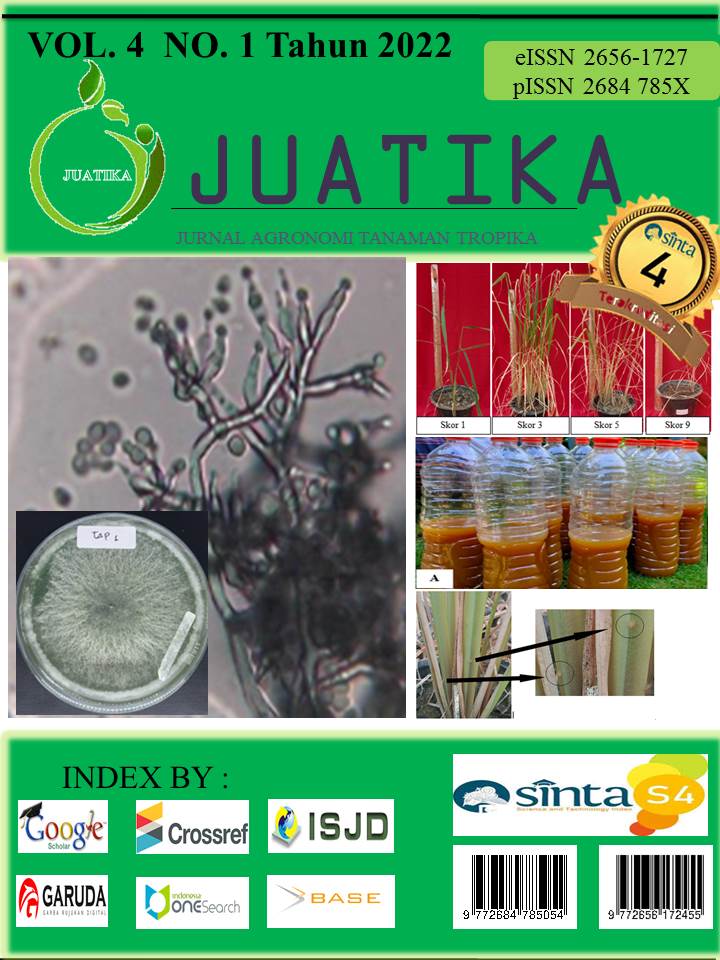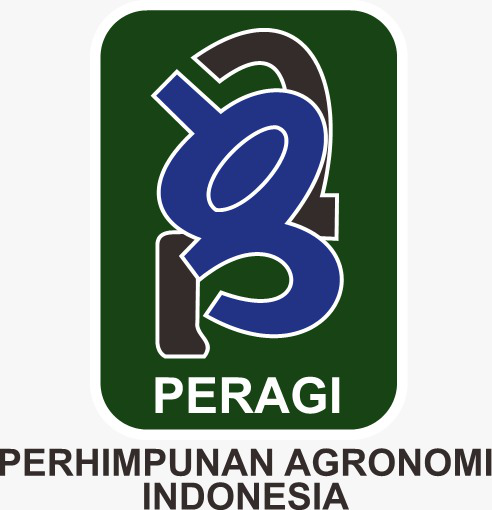Rhizospheric Fungus: Morphological Characterization Of Rhizosphere Flower On Onion Plant In Enrekang District
Abstract
The control of moler disease caused by Fusarium oxysporum on shallot plants in Enrekang Regency still relies on the use of chemical fungicides. Plants that are symbiotic with microbes will produce phytohormones optimally so that it will trigger the tolerance level of plants to abiotic and biotic stresses including plant pathogens, so it is necessary to explore the rhizosphere fungi of onion plants in Enrekang Regency to identify morphologically. This study used a red onion soil rhizosphere soil sample taken at the shallot farming center in Enrekang Regency, isolation and testing were carried out in the plant disease laboratory of Hasanuddin University. The results achieved were 20 isolates with 5 genera of fungi namely Fusarium on isolates 1,2,4,12 and 13, Gliocladium on isolates number 15,
Downloads
References
Abri, Tutik Kuswinanti2, ELS and RS (2015). Production of Indole Acetic Acid (IAA) Hormone from Fungal Isolates Collected from Rhizosphere of Aromatic Rice in Tana Toraja. International Journal of Current Research in Biosciences and Plant Biology, 2(6), 88–93.
An, Y., Wang, X., Ji, S., Han, J., Wang, Y., Ma, L., & Liu, Z. (2021). A novel Trichoderma asperellum isolate promoting the growth, detoxification, and antifungal abilities of Arabidopsis thaliana seedlings under Fusarium oxysporum toxin stress. Journal of Plant Pathology, 0123456789. https://doi.org/10.1007/s42161-021-00871-9
Gusmiaty and Siti Halimah Larekeng. (2020). Characterization of Rhizosphere Fungi on Mahogany Stands in Hasanuddin University Education Forest Characterization of Rhizosphere Fungi Mahogany at Experimental Forest Hasanuddin University. Galung Tropics, 9(3), 276–285.
Hammad, M., Guillemette, T., Alem, M., Bastide, F., & Louanchi, M. (2021). First report of three species of Trichoderma isolated from the rhizosphere in Algeria and the high antagonistic effect of Trichoderma brevicompactum to control gray mold disease of tomato. Egyptian Journal for Biological Pest Control, 4.
Hikmahwati, Muhammad Rifqy Aulia, Ramlah, Fitrianti, H. (2020). Identification of Fungi that Cause Moler Disease on Shallots (Allium Ascolonicum L.) In Enrekang Regency. AGROVITAL : Journal of Agricultural Sciences, 5(November), 83–86.
Hunter, HLB and BB (2006). Illustrated Genera of Imperfect Fungi (fourth). The American Phytopathological Society.
Iradhatullah Rahim, Suherman, H. (2019). Gibberellin Hormone Production From Fungus From Cocoa Plants. Proceedings of the 2019 National Seminar on Multidisciplinary Synergy of Science and Technology, Vol. 2 , 2019 , ISSN : 2622-0520, 2, 26–27.
Kurniati Era., Delita Zul, BT (2020). Isolation and Identification of Seed-borne Fungi Acacia crassicarpa A. Cunn. Ex Benth. Juatika Journal of Tropical Crop Agronomy, isolate 2012, 19–30.
Mubashar, M., Ghazanfar, M.., Muzammil, H., Zafar, I., & Yasir, I. (2011). Pathogenic and Non-Pathogenic Fungi Isolated From Soil and. Pakistan Journal of Phytopathology, 25(01), 95–100.
Prakoso, EBPrakoso, SW, & H., N. (2016). Endurance Test on Different Cultivars Shallots (Allium ascalonicum) Against Infectious. Endurance Test on Different Cultivars Shallots (Allium ascalonicum) Against Infectious. Plumula, 5(1).
Seyis Bilkay, I., Karakoç, ., & Aksöz, N. (2010). Aspergillus niger'den indole acetic asit ve gibberellik asit üretimi. Turkish Journal of Biology, 34(3), 313–318. https://doi.org/10.3906/biy-0812-15
Suganda T., ASR (2020). The potential of shallot rhizosphere fungi in suppressing Fusarium oxysporum f. sp. cepae , the cause of bulb rot disease of shallots The potential of shallot rhizospheric fungi in suppressing Fusarium oxysporum f . sp. cepae , the causal agent of basal rot di. Cultivation Journal Vol. 19 (1) March 2020, 19(1), 1015–1022.
Susanti, A., Aziz, AA, & Muhibuddin, A. (2021). The Effectiveness Of Adding Mycorrhizes And Fertilizer Composition On The Growth Of Spinach ( Amaranthus sp ). Juatika Journal of Tropical Crop Agronomy, 3(2).
Tambingsila, M. (2016). The Potential of Cocoa Plants As A Control Antagonist (Phytophthora palmivora Bult.) Causes Rot. Journal of Agropets, 13(1), 12–23.
TURAEVA, B., SOLIEV, A., ESHBOEV, F., KAMOLOV, L., AZIMOVA, N., KARIMOV, H., ZUKHRITDINOVA, N., & KHAMIDOVA, K. (2020). The use of three fungal strains in producing of indole-3-acetic acid and gibberelllic acid. Plant Cell Biotechnology and Molecular Biology, 21(35 36), 32–43.
Xa, LT, & Nghia, NK (2020). Antagonistic activity against plant pathogenic fungus by various indigenous microorganisms from different cropping systems in Soc Trang Province, Vietnam. Environment and Natural Resources Journal, 18(3), 249–256. https://doi.org/10.32526/ennrj.18.3.2020.23
Zulfikar. (2017). Level of Pesticide Use on Shallots in Anggeraja District, Enrekang Regency [Hasanuddin]. http://digilib.unhas.ac.id/uploaded_files/temporary/DigitalCollection/MDJmMDE1ZTYxYmY1ZTdiYzYwYmZlNzZiMTg5M2MxYmZlYWIwNTgwYw==.pdf
Copyright (c) 2022 Hikmahwati hikmahwati Hikmahwati

This work is licensed under a Creative Commons Attribution 4.0 International License.
Authors who publish with Jurnal Agronomi Tanaman Tropika (JUATIKA) agree to the following terms:
Authors retain copyright and grant the Jurnal Agronomi Tanaman Tropika (JUATIKA) right of first publication with the work simultaneously licensed under a Creative Commons Attribution License (CC BY 4.0) that allows others to share (copy and redistribute the material in any medium or format) and adapt (remix, transform, and build upon the material for any purpose, even commercially) with an acknowledgment of the work's authorship and initial publication in Jurnal Agronomi Tanaman Tropika (JUATIKA).
Authors are able to enter into separate, additional contractual arrangements for the non-exclusive distribution of the journal's published version of the work (e.g., post it to an institutional repository or publish it in a book), with an acknowledgment of its initial publication in Jurnal Agronomi Tanaman Tropika (JUATIKA). Authors are permitted and encouraged to post their work online (e.g., in institutional repositories or on their website) prior to and during the submission process, as it can lead to productive exchanges, as well as earlier and greater citation of published work.







 More Information
More Information



